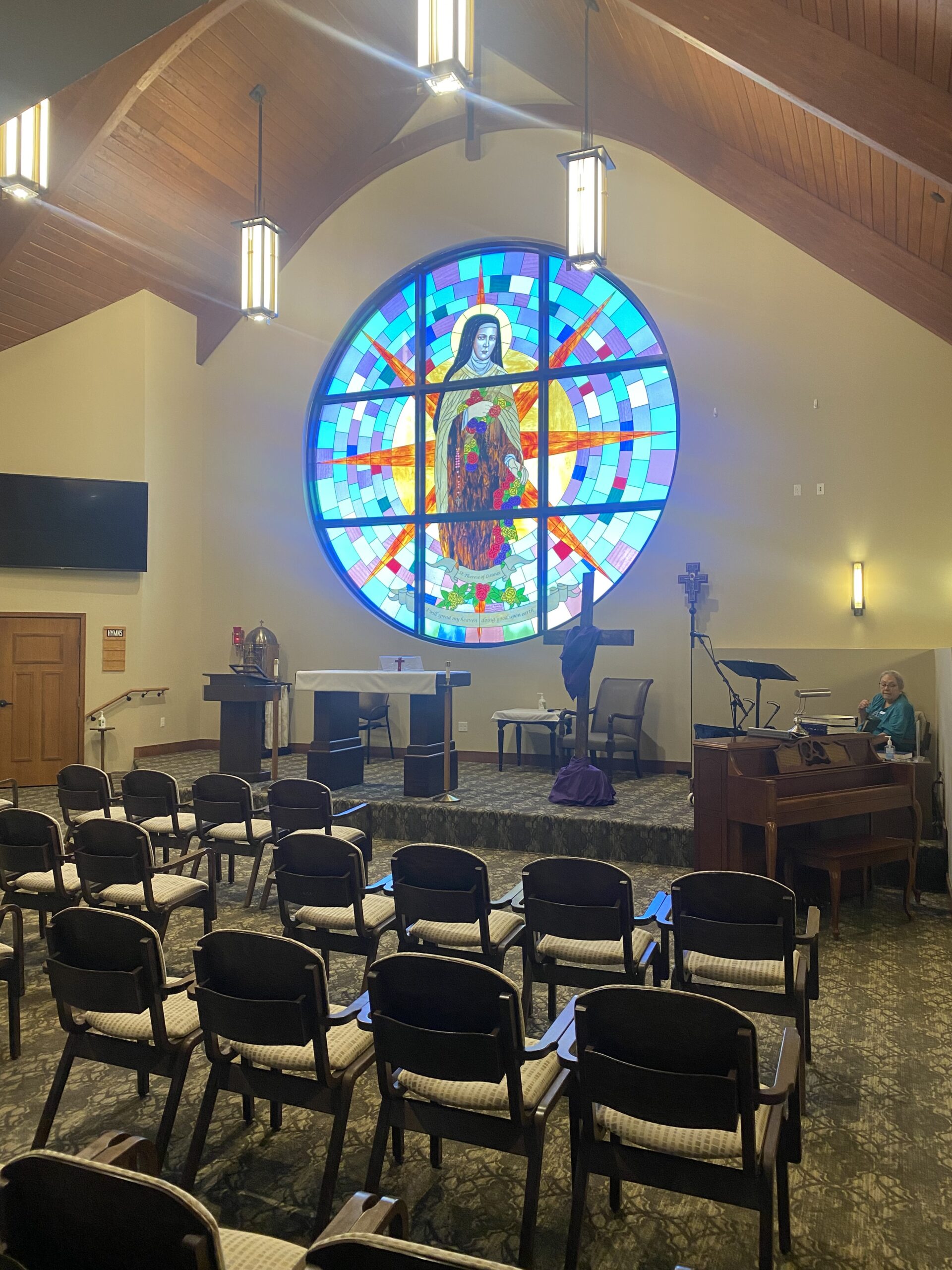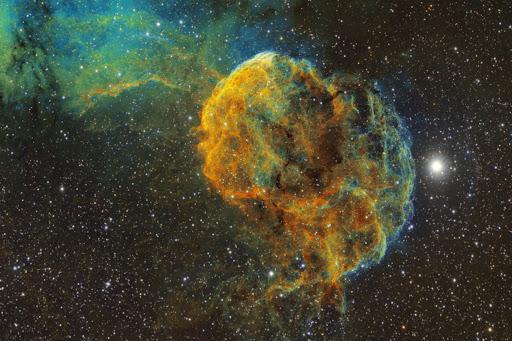

IC 443 (also known as the Jellyfish Nebula and Sharpless 248 (Sh2-248)) is a galactic supernova remnant (SNR) in the constellation Gemini. On the plane of the sky, it is located near the star Eta Geminorum. Its distance is roughly 5,000 light years from Earth.
IC 443 may be the remains of a supernova that occurred 30,000 – 35,000 years ago. The same supernova event likely created the neutron star CXOU J061705.3+222127, the collapsed remnant of the stellar core. IC 443 is one of the best-studied cases of supernova remnants interacting with surrounding molecular clouds.

see full post...
Kermit Holden “Pete” Johnson (March 25, 1904 – March 23, 1967 Kansas City, MO) was an American boogie-woogieand jazz pianist.
Tony Russell stated in his book The Blues – From Robert Johnson to Robert Cray that “Johnson shared with the other members of the ‘Boogie Woogie Trio’ the technical virtuosity and melodic fertility that can make this the most exciting of all piano music styles, but he was more comfortable than Meade Lux Lewis in a band setting; and as an accompanist, unlike Lewis or Albert Ammons, he could sparkle but not outshine his singing partner”. Scott Yanow for AllMusic, wrote: “Johnson was one of the three great boogie-woogie pianists”, the others being Lewis and Ammons “whose sudden prominence in the late 1930s helped make the style very popular”.
see full post...Aretha Louise Franklin (March 25, 1942 – August 16, 2018 Memphis, TN) was an American singer, songwriter and pianist. Referred to as the “Queen of Soul“, Rolling Stone twice named her as the greatest singer of all time. With global sales of over 75 million records, Franklin is one of the world’s best-selling music artists.
As a child, Franklin was noticed for her gospel singing at New Bethel Baptist Church in Detroit, Michigan, where her father C. L. Franklin was a minister. At the age of 18, she was signed as a recording artist for Columbia Records. While her career did not immediately flourish, Franklin found acclaim and commercial success once she signed with Atlantic Records in 1966. She recorded acclaimed albums such as I Never Loved a Man the Way I Love You (1967), Lady Soul (1968), Spirit in the Dark (1970), Young, Gifted and Black (1972), Amazing Grace (1972), and Sparkle (1976), before experiencing problems with the record company. Franklin left Atlantic in 1979 and signed with Arista Records. Her success continued with the albums Jump to It (1982), Who’s Zoomin’ Who? (1985), Aretha (1986) and A Rose Is Still a Rose (1998).
Franklin recorded 112 charted singles on the US Billboard charts, including 73 Hot 100 entries, 17 top-ten pop singles, 100 R&B entries and 20 number-one R&B singles. Her best-known hits include “I Never Loved a Man (The Way I Love You)“, “Respect“, “(You Make Me Feel Like) A Natural Woman“, “Chain of Fools“, “Think“, “I Say a Little Prayer“, “Ain’t No Way“, “Call Me“, “Don’t Play That Song (You Lied)“, “Spanish Harlem“, “Rock Steady“, “Day Dreaming“, “Until You Come Back to Me (That’s What I’m Gonna Do)“, “Something He Can Feel“, “Jump to It“, “Freeway of Love“, “Who’s Zoomin’ Who“, “I Knew You Were Waiting (For Me)” (a duet with George Michael) and “A Rose Is Still a Rose“. Aside from music, she appeared in the 1980 film The Blues Brothers.
Franklin received numerous honors throughout her career. She won 18 Grammy Awards (out of 44 nominations), including the first eight awards given for Best Female R&B Vocal Performance (1968–1975), a Grammy Awards Living Legend honor and Lifetime Achievement Award. She was also awarded the National Medal of Arts and the Presidential Medal of Freedom. In 1987, she became the first female artist to be inducted into the Rock and Roll Hall of Fame. Her other inductions include the UK Music Hall of Fame in 2005, the Gospel Music Hall of Fame in 2012, and posthumously the National Women’s Hall of Fame in 2020. In 2019, the Pulitzer Prize jury awarded her a posthumous special citation “for her indelible contribution to American music and culture for more than five decades”.
see full post...Stephen Paul Motian (March 25, 1931 – November 22, 2011 Philadelphia, Pennsylvania) was an American jazz drummer, percussionist, and composer. Motian played an important role in freeing jazz drummers from strict time-keeping duties.
He first came to prominence in the late 1950s in the piano trio of Bill Evans, and later was a regular in pianist Keith Jarrett‘s band for about a decade (c. 1967–1976). Motian began his career as a bandleader in the early 1970s. Perhaps his two most notable groups were a longstanding trio of guitarist Bill Frisell and saxophonist Joe Lovano, and the Electric Bebop Band where he worked mostly with younger musicians on interpretations of bebop standards.
see full post...Cecil Percival Taylor (March 25, 1929 – April 5, 2018) was an American pianist and poet. Taylor was classically trained and was one of the pioneers of free jazz. His music is characterized by an energetic, physical approach, resulting in complex improvisation often involving tone clusters and intricate polyrhythms. His technique has been compared to percussion. Referring to the number of keys on a standard piano, Val Wilmer used the phrase “eighty-eight tuned drums” to describe Taylor’s style. He has been referred to as being “like Art Tatum with contemporary-classical leanings”. Cecil Percival Taylor was born on March 25, 1929, in Long Island City, Queens, and raised in Corona, Queens.
see full post...The shadow of the Moon can be seen darkening part of Earth. This shadow moved across the Earth at nearly 2000 kilometers per hour. Only observers near the center of the dark circle see a total solar eclipse – others see a partial eclipse where only part of the Sun appears blocked by the Moon. This spectacular picture of the 1999 August 11 solar eclipse was one of the last ever taken from the Mir space station. The two bright spots that appear on the upper left are thought to be Jupiter and Saturn. Mir was deorbited in a controlled re-entry in 2001. A new solar eclipse will occur over North America in about two weeks.

see full post...
Paul Brownlee McCandless Jr. (born March 24, 1947) is a multi-instrumentalist and founding member of the American jazz group Oregon. He is one of the few jazz oboists. He also plays bass clarinet, English horn, flute, penny whistle, tenor saxophone, sopranino saxophone, and soprano saxophone.
Paul Brownlee McCandless Jr. was born in Indiana, Pennsylvania, United States, into a musical family. His father (who was also an oboe and English horn player) taught him clarinet, his mother piano, and he attended the Manhattan School of Music. In 1971 he auditioned with the New York Philharmonic playing English horn and was a finalist.
McCandless has released a series of records of his own compositions with bands he led, including All the Mornings Bring (Elektra/Asylum, 1979), Navigator (Landslide, 1981), Heresay (Windham Hill, 1988), Premonition (Windham Hill, 1992). With Oregon, he has recorded over twenty albums, as well as several albums with Paul Winter.
see full post...Lee Oskar (born 24 March 1948) is a Danish harmonica player, notable for his contributions to the sound of the rock-funk fusion group War, which was formed by Howard E. Scott and Harold Brown, his solo work, and as a harmonicamanufacturer.He continues to play with 3 other original War band members, Harold Brown, Howard Scott and B.B. Dickerson, under the name LowRider Band.
see full post...Carol Kaye (née Smith; born March 24, 1935) is an American musician. She is one of the most prolific recorded bass guitarists in rock and pop music, playing on an estimated 10,000 recordings in a career spanning over 65 years.
see full post...King Pleasure (born Clarence Beeks; March 24, 1922 – March 21, 1982) was an American jazzvocalist and an early master of vocalese, where a singer sings words to a well-known instrumental solo.
see full post...Sharpless 2-106 (Sh2-106 or S106 for short) is a bipolar emission nebula and HII region. It measures about 2 light-years long by 0.5 light-year wide and is located about 2,000 light-years away in the constellation of Cygnus (the Swan), in a relatively isolated region of the Milky Way. Its mass may be as high as 25,000 times the mass of our Sun.

David Jay Grisman (born March 23, 1945) is an American mandolinist. His music combines bluegrass, folk, and jazz in a genre he calls “Dawg music”. He founded the record label Acoustic Disc, which issues his recordings and those of other acoustic musicians. He was inducted into the International Bluegrass Music Hall of Fame in 2023.
Grisman grew up in a Conservative Jewish household in Passaic, New Jersey. His father was a professional trombonist who gave him piano lessons when he was seven years old. As a teenager, he played piano, mandolin, and saxophone.
In the early 1960s, he attended New York University. He belonged to the Even Dozen Jug Band with Maria Muldaur and John Sebastian. He played in the bluegrass band the Kentuckians led by Red Allen, then in the psychedelic rock band Earth Opera with Peter Rowan. He moved to San Francisco, met Jerry Garcia, and appeared on the Grateful Dead album American Beauty. He played in Garcia’s bluegrass band Old & In the Way with Peter Rowan and Vassar Clements. When Grisman was 17 years old, he was invited on stage by Doc Watson to join him on mandolin for a rendition of “In the Pines”.
see full post...David Samuel Pike (March 23, 1938 – October 3, 2015) was an American jazz vibraphone and marimbaplayer. He appeared on many albums by Nick Brignola, Paul Bley and Kenny Clarke, Bill Evans, and Herbie Mann. He also recorded extensively as leader, including a number of albums on MPS Records.
He learned drums at the age of eight and was self-taught on vibraphone. Pike made his recording debut with the Paul Bley Quartet in 1958. He began putting an amplifier on his vibes, when working with flautist Herbie Mann in the early-1960s. By the late-1960s, Pike’s music became more exploratory, contributing a unique voice and new contexts that pushed the envelope in times remembered for their exploratory nature. The Doors of Perception, released in 1970 for the Atlantic Records subsidiary Vortex Records, and produced by former boss Herbie Mann, explored ballads, modal territory, musique concrète, with free and lyrical improvisation, and included musicians including alto saxophonist Lee Konitz, bassist Chuck Israels and pianist Don Friedman.
see full post...
Granville Henry “Stick” McGhee (March 23, 1918 – August 15, 1961) was an American jump bluesguitarist, singer and songwriter, best known for his blues song “Drinkin’ Wine, Spo-Dee-O-Dee“, which he wrote with J. Mayo Williams.
McGhee was born in Knoxville, Tennessee, and grew up in Kingsport, Tennessee. He received his nickname when he was a child. He used a stick to push a wagon carrying his older brother Brownie McGhee, who had contracted polio. Granville began playing the guitar when he was thirteen years old. After his freshman year he dropped out of high school and worked with his father at the Eastman Kodaksubsidiary, Tennessee Eastman Company in Kingsport. In 1940, Granville quit his job and moved to Portsmouth, Virginia, and then to New York City. He entered the military in 1942 and served in the U.S. Army during World War II. After being discharged in 1946, he settled in New York.
see full post...